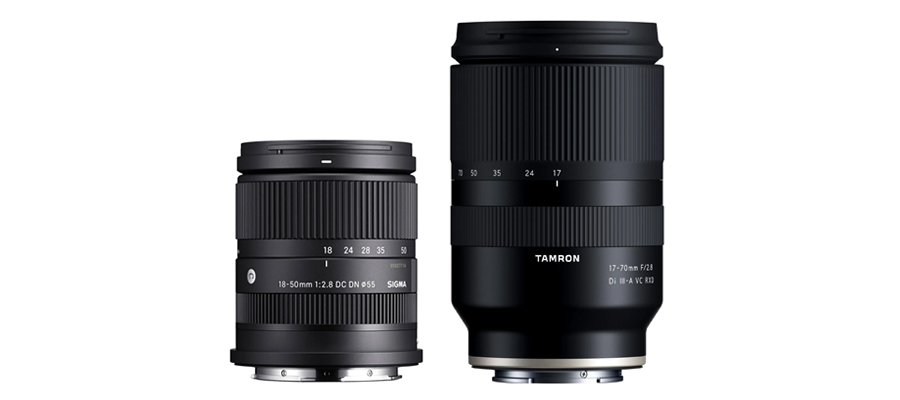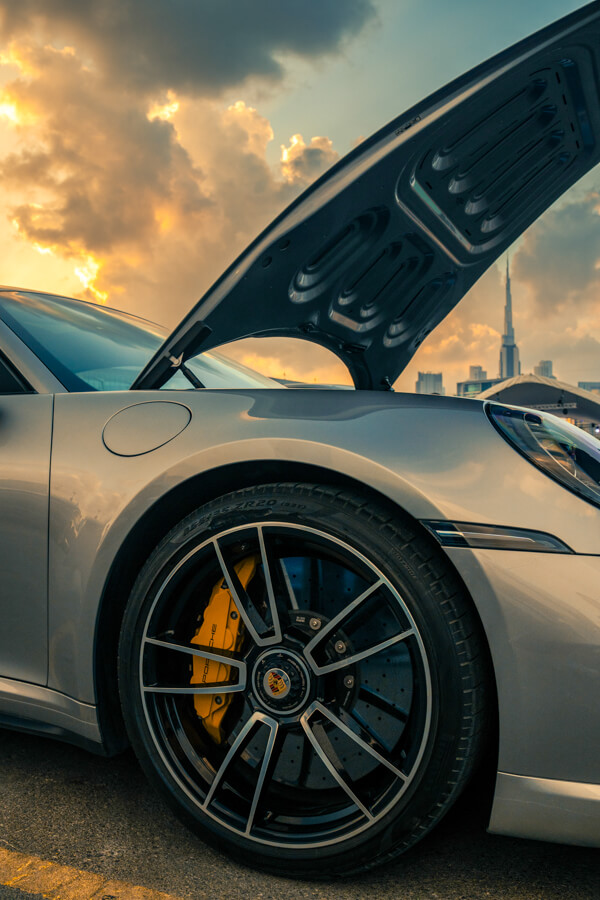
The Sigma 18-50mm f/2.8 DC DN and Tamron 17-70mm f/2.8 Di-III A VC RXD are both excellent zoom lenses suitable for many different types of photo/video.
Sigma 18-50mm f/2.8 DC DN
- Focal Length: 18-50mm
- Max Aperture: f/2.8
- Mount: Sony, Fuji
- Stabilized: ❌
- Weather-Sealing: ❌
- Weight: 290g
- Released: 2021
- Amazon ($)
Tamron 17-70mm f/2.8 Di VC RXD
- Focal Length: 17-70mm
- Max Aperture: f/2.8
- Mount: Sony, Fuji
- Stabilized: ✔️
- Weather-Sealing: ✔️
- Weight: 525g
- Released: 2023
- Amazon ($$)
In this comparison, I will show you how the Sigma 18-50mm f/2.8 and Tamron 17-70mm f/2.8 compare at different photography types, image quality, along with a detailed table of their most important features.
If you’re in a hurry, the advantages below are all you need to make the final decision.
Advantages of Sigma 18-50mm f/2.8 DC DN
Advantages of Tamron 17-70mm f/2.8 Di III-A RXD VC
Now, let’s see which features and advantages are actually important for your specific needs and which ones only sound good on paper.
Sigma vs Tamron: Detailed Comparison
🔭 1. Focal Length
- Sigma 18-50mm: From 18mm to 50mm
- Tamron 17-70mm: From 17mm to 70mm
- Winner: Tamron 🏆
The Tamron 17-70mm f/2.8 Di VC offers 33% more telephoto zoom (70mm vs 50mm).
It’s not an enormous difference, but it’s enough that you can get noticeably closer to your subject. For weddings, travel and portraits, this 20mm difference can often come handy if you don’t know what your environment will be like.
On the wide end, the Tamron 17-70mm f/2.8 is 1mm wider than the Sigma 18-50mm f/2.8 DG DN. It’s a very small difference. However, for real estate photography, that extra 1mm wider focal length will let you capture a bit more of the room in your shot.

🎥 2. Maximum Aperture
- Sigma 18-50mm: Constant maximum aperture of f/2.8 at all focal lengths
- Tamron 17-70mm: Constant maximum aperture of f/2.8 at all focal lengths
- Winner: Tie
Both Sigma 18-50mm f/2.8 DG DN and the Tamron 17-70mm f/2.8 Di VC have a constant f/2.8 aperture, which is great news for shooting in low light or less than ideal lighting conditions.
You can always select a smaller aperture, but f/2.8 is also great for blurring the background. This is useful for weddings, portraits, animals and macro photography.
📏 3. Dimensions & Weight
- Sigma 18-50mm: 290g
- Tamron 17-70mm: 525g
- Winner: Sigma 🏆
The Sigma 18-50mm f/2.8 DG DN is almost half the weight of the Tamron 17-70mm f/2.8 Di VC. It’s 45% lighter and way less of a burden to carry around.
Both lenses are made for APS-C cameras, but the Sigma 18-50mm f/2.8 is truly a more compact choice. If you want to travel light, or don’t always use your camera because of its size, this is super important.
The Tamron 17-70mm f/2.8 Di VC is not a huge bulky lens, but you do lose that compactness factor. You can’t just put it in any pocket or smaller bag.
- Sigma 18-50mm: 65.4 x 74.5mm
- Tamron 17-70mm: 74.6 x 119.3mm
- Winner: Sigma 🏆
The Sigma 18-50mm f/2.8 DC DN is 40% shorter than the Tamron 17-70mm f/2.8 Di VC.
One of the reasons is obviously the shorter zoom capability, seeing as it stops at 50mm compared to 70mm on the Tamron. Also, there is no Image Stabilization mechanism with the Sigma, which helps reduce the amount of elements needed.
🎥 4. Minimum Aperture
- Sigma 18-50mm: f/22
- Tamron 17-70mm: f/16
- Winner: Sigma 🏆
The Sigma 18-50mm f/2.8 DG DN can stop down up to f/22, which is 1 stop smaller than f/16 on the Tamron 17-70mm f/2.8 Di VC.
Is this a big deal? No, but in those rare situations where you might need to shoot with such a small aperture, it’ll block more light and provide a greater depth of field. You’ll be able to get even more in complete focus, which is useful for landscape photography.
🔬 5. Minimum Focusing Distance
- Sigma 18-50mm: Minimum focusing distance of 12.1 cm at 18mm
- Tamron 17-70mm: Minimum focusing distance of 19 cm at 17mm
- Winner: Sigma 🏆
A shorter minimum focusing distance allows you to get much closer to your subject. Remember, these distances are measured from your camera’s sensor and not from the front of the lens.
The Sigma 18-50mm f/2.8 DC DN offers an incredible 12.1cm minimum focusing distance. In certain situations, you might actually be touching the subject with the front element of your lens.
The Tamron 17-70mm’s f/2.8 Di VC with its 19cm minimum focusing distance is no joke either, but it won’t let you get as many crazy angles and close-ups.

⛅ 6. Weather-Sealing
- Sigma 18-50mm: ❌
- Tamron 17-70mm: ✔️
- Winner: Tamron 🏆
The Tamron 17-70mm f/2.8 Di VC is completely weather-sealed. This makes it an obvious winner if you plan on traveling in harsh conditions (snow blizzards, severe storms, etc.).
For casual use, all lenses can handle a normal amount of rain, snow and dust. The Sigma 18-50mm f/2.8 DG DN is perfectly fine for shooting in light rain, but it’s only weather-sealed at the mount.
If you’re certain that most of your outdoor photography will be done in difficult weather, the Tamron 17-70mm lens will allow you to travel stress-free.
🎦 7. Image Stabilization
- Sigma 18-50mm: ❌
- Tamron 17-70mm: ✔️
- Winner: Tamron 🏆
Image stabilization helps make your images appear less blurry when shooting with slow shutter speeds.
If your mirrorless cameras does not have built-in stabilization, the Tamron 17-70mm f/2.8 Di VC will make your life easier in low-light scenarios or indoor events with bad lighting. The term VC in its name stands for Vibration Reduction; that’s how Tamron refers to this technology.
For recording videos, image stabilization can also help reduce some shake and jitter, although the positive effects are more obvious when taking pictures.
The Sigma 18-50mm f/2.8 DG DN does not come with any stabilization in order to keep its size compact. If your mirrorless camera offers built-in stabilization, then both lenses are fine.
💿 8. Aperture Blades
- Sigma 18-50mm: 7 rounded diaphragm blades
- Tamron 17-70mm: 9 rounded diaphragm blades
- Winner: Tamron 🏆
A lens with more diaphragm blades will usually produce smoother bokeh, aka background blur.
The Tamron 17-70mm f/2.8 Di VC has 9 blades versus 7, which is not a big difference, and the bokeh quality also depends on the quality of the lens itself. However, it never hurts to have more!
📽 9. Filter Size
- Sigma 18-50mm: 55m filter size
- Tamron 17-70mm: 67mm filter size
- Winner: Sigma 🏆
The Sigma 18-50mm f/2.8 DG DN accepts 55mm filters, which are super affordable and easy to find.
For the Tamron 17-70mm f/2.8 Di VC, you’ll need to spend a little bit more for your filters, but 67mm is such a standard size that it will also be just as easy to find one in stock.
Filter size is rarely a buying factor, but if you record a lot of videos and have a whole set of ND filters for one size already, it might be wise to think whether it’s worth buying new ones as well.
💲 10. Price
- Sigma 18-50mm: ~$549
- Tamron 17-70mm: ~$700
- Winner: Sigma 🏆
The Sigma 18-50mm f/2.8 DG DN costs about ~$150 less than the Tamron 17-70mm f/2.8 Di VC.
Both lenses are priced pretty fair; if you don’t need the stabilization or weather-sealing of the Tamron, and prefer a more compact zoom, going with the Sigma will be much easier on your wallet.
Sigma vs Tamron: Photography Type
From 1 being the worst, 5 being the best.
It’s best to choose a lens that suits your favorite photography types, or offers you something that your current gear is not good enough for.
As you can see, both lenses are nearly identical for most types of photography.
The 18-50mm and 17-70mm focal length is ideal for traveling and all-around photography. This includes portraits, landscape and even regular sports photography.
Sigma vs Tamron: Comparison Table
Better specifications are highlighted in green.
| 🎥 Lens Specification | Sigma 18-50mm f/2.8 | Tamron 17-70mm f/2.8 |
|---|---|---|
| Focal Length | 18-50mm | 17-70mm |
| 35mm Equivalent | 27-75mm | 25.5-105mm |
| Mount | Sony E, Fuji X (APS-C) | Sony E, Fuji X (APS-C) |
| Maximum Aperture | f/2.8 | f/2.8 |
| Minimum Aperture | f/22 | f/16 |
| Filter Size | 55 mm | 67 mm |
| Maximum Magnification | 0.36x | 0.21x |
| Minimum Focus Distance | 12.1 cm | 19 cm |
| Aperture Ring | No | Yes |
| Focus Type | Autofocus | Autofocus |
| Motor Type | Stepping Motor | Stepping Motor |
| Lens Construction | 13 elements in 10 groups | 16 elements in 12 groups |
| Aperture Blades | 7 (rounded) | 9 (rounded) |
| Image Stabilization | ❌ | ✔️ |
| Weather Sealing | ❌ | ✔️ |
| Dimensions (mm) | 65.4 x 74.5mm | 74.6 x 119.3mm |
| Weight (g) | 290g | 525g |
| Hood Included | Yes | No |
| Released | 2021 | 2023 |
| Price | Amazon | Amazon |
So, which lens is the better one?

Choose the Sigma 18-50mm f/2.8 if:
- You want a much smaller and lighter lens (45% lighter)
- You often shoot macro, close-up photography
- Your camera already has built-in stabilization
- You want to spend as little as possible (~$150 cheaper)
Choose the Tamron 17-70mm f/2.8 if:
- You want more telephoto zoom (70 vs 50mm)
- Your camera doesn’t have image stabilization built-in
- You shoot in difficult conditions and want the best weather-sealing

